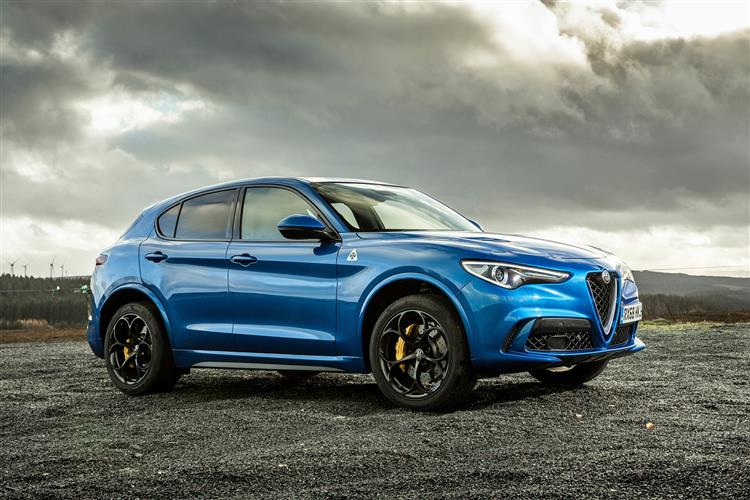FAST AND FURIOUS (some text hidden) --NONE--
By Jonathan Crouch
Introductionword count: 82
What might arguably the fastest SUV you can buy be like? According to Alfa Romeo, the Stelvio Quadrifoglio, launched in 2018, was it. Rivals from that period made similar claims but from this Italian high performance SUV seemed to have the firepower to match its bravado, offering the same Ferrari-derived twin turbo V6 that featured in the glorious Giulia Quadrifoglio super sports saloon. This top Stelvio was lightly revised in 2023. Here, we look at the earlier 2018-2023 versions of this model.
Modelsword count: 5
5dr SUV (2.9 V6 petrol)
Historyword count: 212
It's rather refreshing in automotive world currently obsessed with electrification to come across a car like this. Proper sports cars might be a dying breed but proper sports car engines were in this case very much alive and well. And the Alfa Romeo Stelvio Quadrifoglio model we look at here absolutely has one; a turbocharged 510hp V6 bi-turbo shoe-horned in below its carbon fibre bonnet. This powerplant was designed by former Ferrari engineer - Gianluca Pivetti. And another ex-Ferrari engineer, Philippe Krief, handled the team responsible for trying to make this big SUV handle somewhere in the same ballpark as the Alfa Romeo Giulia Quadrifoglio saloon that shares nearly all this fast Stelvio's engineering. Which is quite a task given that this SUV is 200kg heavier. Early 2020 brought a light upgrade, with technology, design, and safety upgrades. For the outside, changes were limited to LED rear lights, three new paint colours and a carbon fibre front grille. Inside there was a redesigned centre console, a switch away from carbon trim to leather and the addition of Level 2 autonomy features including traffic jam and highway assist. A further update package was announced for the 2024 model year, but it's the earlier 2018-2023-period Stelvio Quadrifoglio models we're going to look at here.
What You Getword count: 561
The taut proportions of the Stelvio work well with the Quadrifoglio embellishment. Visual changes made as part of the 2020 update were slight. On those updated models, a smarter glossy black finish adorns what Alfa calls the front trilobe, the brand's unique heart-shaped front grille with its stylish cross and dragon badge. With all versions of this model, you get bespoke bumpers and piercing bi-xenon headlamps give the car some serious overtaking presence. Inside, there's a cockpit that to some extent at least, succeeds in combining classic Alfa charisma with modern functionality. In this Quadrifoglio variant, it was set apart with red-stitched sports seats upholstered in a leather-and-alcantara combination. The dashboard and the door panels are also wrapped in stitched leather and there are carbon fibre inserts around the fascia and the lower centre console, plus Quadrifoglio cloverleaf badging on the steering wheel and the rev counter. Changes made to 2020 updated model included a revised leather-trimmed steering wheel and a much nicer gear stick under which, evocatively, is a little Italian flag. But the key improvement was the 8.8-inch centre-dash infotainment display, which became a touchscreen and adopted a more up-to-date layout, with widgets able to be dragged and dropped to create a fully customisable homepage, in which each of the vehicle's functions becomes an app. Access to info is either via the screen, by voice or using the lower (but rather cheap-feeling) lower centre console dial (another thing updated in 2020). The improved centre monitor got a split-screen format so that different things could be viewed all at once - audio, nav and 'phone functions for example. And further horizontal scrolling calls up screens for 'Driver Assistance', 'Climate', 'Vehicle Information', 'Connected Services' and the engine and powertrain-orientated 'Performance Pages'. Also re-designed in 2020 was the 7-inch TFT display in the centre of the instrument cluster, revised to offer more information in a more rational way. This could better show the updated model's freshly added autonomous driving technology features, along with selectable screens for G-Forces, plus digital speed and trip computer data (the latter two displaying with a lower fuel economy meter). When it's time to take a seat in the rear, taller folk might find access hindered a little by the swept-back roofline. Still, the rear door opens decently wide and once inside, there's a lot more headroom than the sleek silhouette previously led you to expect. Leg room though, isn't quite as good as in some direct rivals - though it's better than in a Porsche Macan - and a couple of talk folk sat behind a lanky driver will find their knees very close indeed to the scalloped cut-outs indented into the front seat backs. Out back, it was possible for original owners to specify the powered tailgate to include a hands-free feature so that it activates with a swipe of your foot beneath the bespoke bumper. And when it raises, a 525-litre boot is revealed, with compartments under the floor in lieu of the proper spare wheel we'd much rather have. You get a recessed area to the right, four silver tie-down points and a 40:20:40-split backrest so that, if necessary, longer items like skis can be slid in between two rear-seated passengers. If you need more space, pushing forward the rear bench (by pulling on the cargo sidewall-mounted catches) extends the space available to 1,600-litres.
To see the full road test text contact us on 0330 0020 227
Pictures (high res disabled)

.jpg)
|
.jpg)
|
.jpg)
| |||
.jpg)
|
.jpg)
|
.jpg)
| |||
.jpg)
|

|
Scoring (subset of scores)
Category: Sporting Cars
| Performance | |
| Handling | |
| Comfort | |
| Space | |
| Styling, Build, Value, Equipment, Depreciation, Handling, Insurance and Total scores are available with our full data feed. | |



